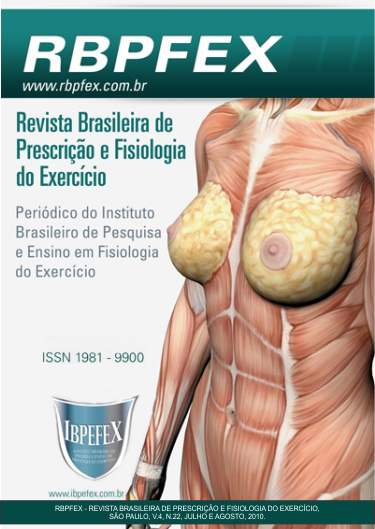Anthropometric changes due to a bicycle touring event
Abstract
Bicycle touring is an outdoor activity that utilizes the bicycle as wayof transportation. The present study aims to verify anthropometrical changes due to a bicycle touring event, in both male and female cyclists, during 498.2 Km across the hills of Santa Catarina’s Serra Geral, with 2,914 meters of altitude. The anthropometric variables were collected in order to determine the body composition, body fat percentage and lean body mass. Results showed a decrease in percentage body fat of 3.14 % and 2.11 % for male and female, corresponding to a loss of to 2.09 and 2.08 Kg. The results also showed a gain of lean body mass of 5.22 Kg for the woman and 3.2 Kg for the man. Both male and female reduced body fat and gained lean body mass just like participants of a two months exercise program, and as well as high intensity ultra-athletes. Although limited to a couple, these results presume that, besides a fun outdoor activity, bicycle touring can positively alter anthropometric variables, reducing body fat percentage while gaining lean body mass.
References
-Associação Brasileira de Normas Técnicas. NBR 15509-1: Cicloturismo: Parte 1: Requisitos para produto, 2007. Guia Quatro Rodas. Edição 2007. São Paulo. Abril. 2007.
-Jackson, A.S.; Pollock, M.L.; Ward, A. Generalized equations for predicting body density of women. Medicine & Science in Sports and Exercise. Madison. Vol. 12. Num. 3. 1980. p.175-82.
-Knechtle, B.; Wirth, A.; Knechtle, P.; Rosemann, T. An Ultra-cycling race leads to decrease in skeletal muscle mass. International Journal of Sports Medicine. Turkey. Vol. 30. Num. 3. 2009. p. 163-167.
-Knechtlet, B.; Schwanke, M.; Knechtle, P.; Kohler, G. Decrease in body fat during an ultra-endurance triathlon is associated with race intensity. British Journal of Sports Medicine. England. Vol. 42. Num. 7. 2008. p. 609-613.
-Liberali, R. Metodologia Científica Prática: um saber-fazer competente da saúde à educação. Florianópolis. (s.n.). 2008.
-Nahas, M.V. Atividade Física, Saúde e Qualidade de Vida: Conceitos e Sugestões para um Estilo de Vida Ativo. 4a Edição rev. e atual. Londrina. Midiograf. 2006.
-Numa, F.S. Mountain Bike Curiosidades. Portal Geocities. 1997. Disponível em: . Acesso em 19 de abril 2009.
-Oliveira Filho, A.; Shiromoto, R.N. Efeitos do Exercício Regular Sobre Índices Preditores de Gordura Corporal: Índice de Massa Corporal, Relação Cintura-Quadril e Dobras Cutâneas. Revista da Educação Física. Maringá. Vol. 12. Num. 2. 2001. p.105-112.
-Pequini, S.M. Ergonomia aplicada ao Design de produto: Um estudo de caso sobre o Design de bicicletas. Tese de Doutorado. São Paulo. Universidade de São Paulo. 2005.
-Pequini, S.M. A evolução tecnológica da bicicleta e suas implicações ergonômicas para a máquina humana: problemas na coluna vertebral X bicicletas dos tipos Speed e Mountain bike. Dissertação de Mestrado. São Paulo. Universidade de São Paulo, 2000.
-Petroski, E. L. Antropometria: Técnicas e Padronizações. 3. ed. rev. e ampl. Blumenau. Nova Letra. 2007.
-Powers, S.K.; Howley, E.T. Fisiologia do Exercício: Teoria e Aplicação ao Condicionamento e ao Desempenho. 5ª Edição. Barueri, Manole. 2005.
-Raymond, C.H.; Joseph, K.F.; Gabriel, Y.F. Recruitment Pattern in Cycling: a Review. Physical Therapy in Sports. London. Vol. 6. Num. 2. 2005. p. 89-96.
-Busto, V. A Bicicleta e Geopolítica. Revista Bici Sport. São Paulo. Pinus. Vol. 35. 1992.
-Schentino, A. M. Cicloturismo como Vivência Crítica e Criativa de Lazer. Texto adaptado de Monografia. Belo Horizonte. Universidade Federal de Minas Gerais. In: V SEMINÁRIO LAZER EM DEBATE. Rio de Janeiro. 2004.
-Sidewells, C. Complete Bike Book. London. Dorling Kindersley Limited. 2003.
-Siri, W. E. Body composition from fluid spaces and density. In: Brozek, J.; Henschel, A.(Eds.). Techniques for measuring body composition. National Academy of Science. Washington. 1961. p. 223-244.
-Xavier, G.N.A.; Giustina, M.D.; Carminatti, L.G. Promovendo a bicicleta para uma vida mais saudável. Disponível em < http://www.cefid.udesc.br/ciclo/documentos/2000/Promocao.Uso.Bicicleta.Cinergis.pdf>. Acesso em 23 de Agosto 2009.
Authors who publish in this journal agree to the following terms:
- Authors retain the copyright and grant the journal the right of first publication, with work simultaneously licensed under the Creative Commons Attribution License BY-NC which allows the sharing of the work with acknowledgment of the authorship of the work and initial publication in this journal.
- Authors are authorized to enter into additional contracts separately for non-exclusive distribution of the version of the work published in this journal (eg, publishing in institutional repository or book chapter), with acknowledgment of authorship and initial publication in this journal.
- Authors are allowed and encouraged to post and distribute their work online (eg, in institutional repositories or on their personal page) at any point before or during the editorial process, as this can bring about productive change as well as increase impact and impact. citation of published work (See The Effect of Free Access).






